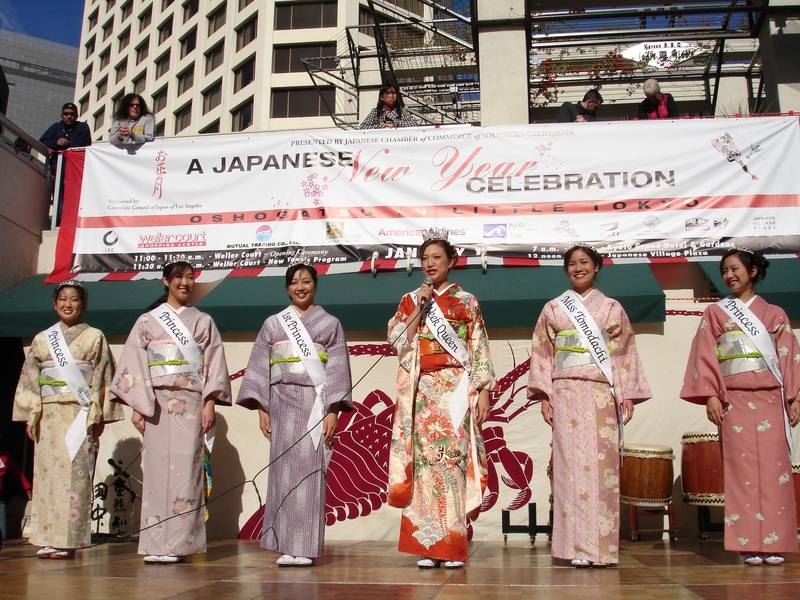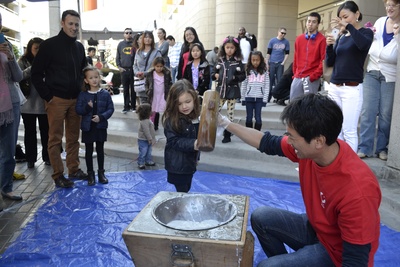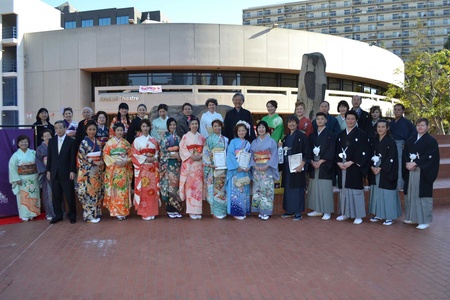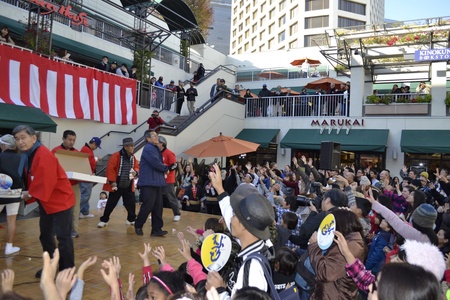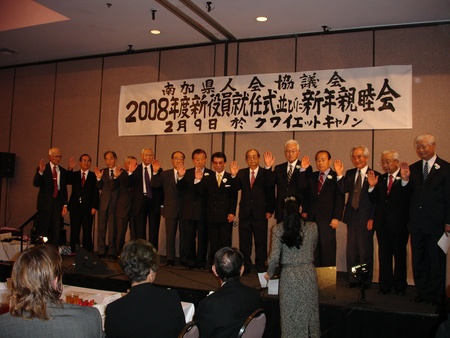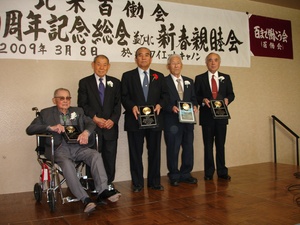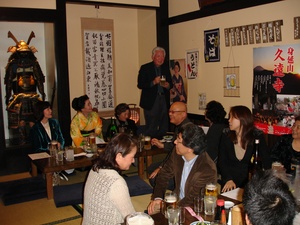“10, 9, 8, 7, 6, 5, 4, 3, 2, 1, Happy New Year!”
It’s a new year. For Americans, it’s their last holiday, but for Nikkei communities in Southern California, it’s the oshogatsu they have all been waiting for. Starting from the first sunrise on January 1st, New Year’s celebrations and inaugural ceremonies of new board members in various communities continue until March. This three-month celebration of New Year is exclusively unique to Southern California where they have the biggest Nikkei communities in the U.S. mainland.
Hatsuhinode (First Sunrise of the Year)—Customs of Shin Issei
In Southern California, it’s a custom of Shin Issei born in Japan, not that of Nikkei Americans, to get up very early in the morning and head to beaches to see the first sunrise of the year.
When I said to my Nikkei Yonsei American friend, “Let’s go see the first sunrise in San Pedro,” I got a response that didn’t quite echo my excitement: “What makes the sunrise on January 1st different from the one on December 31st? For me, it’s the same sunrise.” In my daily communication with Nikkei Americans, I encounter a number of scenes where I clearly see the difference on the inside, which makes them American and me Japanese while we both have the same Japanese face. This little anecdote about the first sunrise is one moment that made me realize our differences, and I find it interesting. Indeed, on Facebook, it’s always Shin Issei or the Japanese who post pictures of the first sunrise.
Thanks to my friend’s simple question, however, I started to think about the reason why the Japanese see the first sunrise of the year as a special thing and where this custom comes from. It’s the benefit of living abroad in diversity that makes me rethink and learn about things that I never had a chance to question because it just felt so natural to have them in my home country.
So as always, I turned to the Internet and typed in the words—first sunrise, origin—in the search box. From what I found, for the Japanese, the first sunrise is a thing to celebrate because historically it’s been said that the age of god appears with the first sunrise of the year. And the custom of seeing the first sunrise is said to have spread to the masses in Meiji Era when Emperor’s shihohai1 resumed on New Year’s Day.2
“Wow, I get it now.” I hadn’t known anything about the significance of the first sunrise for the Japanese, but I had sensed that it was sacred, and to be celebrated. It gave me a feeling that I couldn’t quite describe in words. It’s things like this that makes me think, “I’m Japanese, after all.”
“Oshogatsu in Little Tokyo” and First Visit to Shrine
The Rose Parade and Rose Bowl Game in Pasadena3 are the two most well-known New Year’s events in Southern California, but what about oshogatsu events? Well, they have “Oshogatsu in Little Tokyo,” organized by the Japanese Chamber of Commerce of Southern California, which takes place every year in Little Tokyo in downtown Los Angeles. It’s amazing that so many people from different communities support this event as volunteers. I have much respect for those volunteers who dedicate their last holiday to their communities. It’s the day I see the power of Nikkei communities as well.
On the special stage sets in Weller Court and in the Japanese Village Plaza, Japanese traditions are presented—leaders of Nikkei communities breaking a ceremonial sake barrel, Society of Calligraphy in America demonstrating their calligraphy work, taiko and koto performances, martial arts demonstrations, and kimono shows.
The highlight of the event is mochi-throwing. From the stage in Weller Court, the Nisei Week Queen and Court and Nikkei community leaders throw small mochi (donated by Japanese confectionery Fugetsu-do) to visitors. To get as many as they can, visitors extend their arms to catch mochi thrown from the stage. Sometimes people on the second and third floors in Weller Court request mochi, shouting “We want them too!” so throwing requires some physical power.
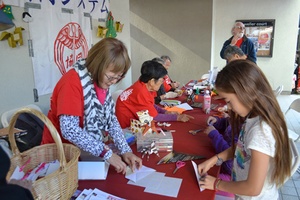
There are some booths for people to experience Japanese culture, and children enjoy oshogatsu by pounding mochi and playing with origami.
Another important event for New Year is the first shrine visit. At Koyasan on First Street, Gantan-shushoue-hatsu-gomakuyo4 is held from morning to celebrate the New Year. In addition to its supporters, many other people visit the temple, so the main hall gets fully packed. Here hamaya (a ceremonial arrow that is believed to ward off evils) is popular. In the old tradition, people sent hamaya to baby boys on their first oshogatsu as a charm against bad luck, but now it’s considered a lucky charm to catch good luck in the New Year.
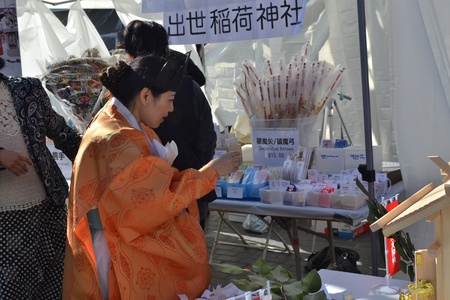
In recent years, there has been a mini-shrine at “Oshogatsu in Little Tokyo.” This shrine belongs to Izumi Hasegawa, a daughter of the Shinto priest at Shusse-inari Shrine in Shimane Prefecture. Hasegawa is a priest herself. Normally she works in public relations interviewing Hollywood celebrities and promoting new films. She sends prayers as a priest at Earthquake Disaster Recovery events in Los Angeles.
There are seven Buddhist temples in the neighborhood of Little Tokyo, but there are no Shinto shrines at all. For me, hatsumode means going to a shrine, not a temple. In the countryside in Japan, a Buddhist temple and a shrine is almost like a pair, and in most cases each region has both. With Japanese culture so deeply rooted, why doesn’t Los Angeles have any shrines? It’s a mystery.
Before World War II, there were approximately 3,000 Issei (who still had Japanese nationality at the time) and Nisei living in Terminal Island near the Port of Los Angeles, and they had shrines there. However, once the war started, the US government ordered the residents on Terminal Island to move out, as there were US Marine bases nearby. After the residents left, all buildings on Terminal Island were demolished, making it a raw land. Shrines were no exception.
Some people say that shrines did not get rebuilt in America after the war because of the memorandum of understanding that the Allied Command Commander General Command (GHQ) issued to the Government of Japan in 1945 which included the Shinto Order. According to a dictionary, the Shinto Order commands “the abolishment of national Shintoism, the complete separation of politics and religion, and the continuation of Shinto as a private religion.”5
It’s interesting to look into Nikkei community traditions. As questions come up, you can learn unexpected things about Japanese history as well.
New Year’s Celebration and Inaugural Ceremonies of New Board Members
Starting from the first Sunday in January, New Year’s celebrations, general assemblies and inaugural ceremonies of new board members of Nikkei organizations can be found every Sunday. In large organizations, it’s common that some board members are also involved with other organizations and are invited to New Year’s celebration of other groups, so they arrange the schedules in a way that prevents two or more events taking place on the same day. This is why the celebration continues until March even though they have events every Sunday. Junichi Ihara, consul general at Consulate-General of Japan in Los Angeles once commented on it in a surprised tone: “The fact that New Year’s celebrations continue until March makes me think about the history of Nikkei communities in Southern California.”
And sometimes events still happen to take place on the same day. If they are taking place in different rooms in the same venue, Nikkei media in Los Angeles reporting on New Year’s celebrations check the programs of the two events and report on them on the same day, while figuring out the best timing to take photos and record videos. Nikkei media moving from one venue to another might be a common sight in Nikkei communities in Los Angeles during New Year’s events.
The Southern California Gardeners’ Federation, Japanese Chamber of Commerce of Southern California, and Japanese Prefectural Association of Southern California are the three largest community organizations in Los Angeles. Major figures in current Nikkei communities come together to the New Year’s celebrations of these three organizations, providing us with a picture of current Nikkei communities in Southern California. In Southern California, 42 kenjinkai (prefectural gatherings) host their own New Year’s celebration. The Okinawa Association of America has many members, and more than 400 people once participated in their events. A smaller kenjikai has about 20 members.
A variety of other organizations host their own New Year’s celebrations and facilitate communication among members: Sakura Gardens, a retirement home of Nikkei seniors, Nikkei Pioneer Center that provides welfare service to Nikkei seniors, Little Tokyo Historical Society that preserves the history of Little Tokyo, Orange County Japanese American Association comprised of Nikkei and the Japanese in Orange County, Southern California Showa Kai, and others.
A planning group at each organization creates a program for their New Year’s celebration and prepares for the event. As they do their preparation while engaged in day-to-day work, Nikkei communities can finally take a little break on the last Sunday in March when all New Year’s celebrations and inaugural ceremonies of new board members come to an end.
Notes:
1. Shihohai or yohohai: A ritual performed by the Emperor on New Year’s Day every year. It was called shihosetsu before and until the middle of the war. On New Year’s Day, in the early morning before sunrise, the Emperor enters a special house, calls gods from all four directions, and sends a prayer—If there are any disasters meant to happen to the nation and its citizens, please send them all to me first. Reference: Emperor’s shihohai (Nezusan-no-hitorigoto)
2. The first sunrise
3. A college football game that takes place at the Rose Bowl stadium, usually on New Year’s Day.
4. A ritual to pray for peace in the New Year. They serve visitors with various charms for warding off evils, traffic safety, and peace at home; fortune slips; hamaya; ema (wooden tablet); and prayer cards.
5. “Shinto Order” (Kotobank)
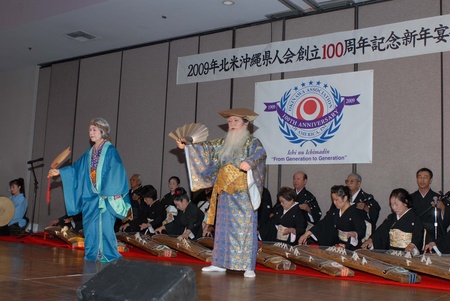
© 2017 Tomomi Kanemaru


